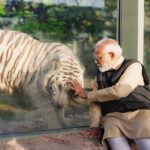A chchay Din Aanay Wale hain (Happy days will come),’ was the slogan coined by Narendra Modi during the parliamentary elections of 2014. ‘Mera Desh Badal Raha Hai (My country is transforming),’ is the new slogan of Mr Modi. This is a perceptive change in Modi’s thinking after taking over as the 14th Prime Minister of India on May 26, 2014. He is the most vigorous Prime Minister in the last 70 years. He has galvanised India. Whether you like or dislike him, but you cannot ignore Modi. India is observing a completely new class of politicians, politics and governance for the last three years. Modi’s biggest achievement is that he has created such a political hype across India that the BJP, which never dreamed of forming a government on its own, has not only captured Raisina Hills but has 17 State governments in its kitty.
No BJP leader has worked and performed so meticulously ever. India is both anxious and excited about Modi for the last three years. Winning elections and capturing power can mesmerise the common man for some time, but good governance which delivers takes time. Modi’s fast-paced team has a yojna (policy) for each of the 56 central ministries. There are approximately more than 90 policies that have been announced till now. Modi has planned to excel at least in three sectors-health, housing and education. All the controlling ministries have been put on full throttle, but progress is still slow. Another important work that Modi desires to finish is making India completely digital. Civil servants have been put on task.
Academicians, who have started analysing Modi’s three years of governance, are not enthused with the performance. I have read many sectoral performance reports which disclose that performance measures only 7-15 per cent with regard to different policies. The policies are made by the Central government and implemented by the State governments. The federal structure of India has its own issues in implementing the policies. Modi is emphasising cooperative, competitive federalism. He has set an agenda beyond 2019; he has started planning for 2022, when India will celebrate “Amritmahotsava” (75 years of India’s independence). It shows his confidence that not only will the BJP win the 2019 elections, but that he will continue serving as the Prime Minister. Modi and BJP have a firm ethos, culture and mindset. As a reporter, I have observed that the Rashtriya Swayamsevak Sangh (RSS) is in complete control of the BJP and, through it, of the government.
The RSS is convinced of the ideas and policies of Modi and has given him almost a free hand to implement his ideas. One insider informed me that the RSS has many leaders, but Modi will not be disturbed till he performs and delivers. The RSS knows that they cannot afford the blunders they committed at the time of Atal Bihari Vajpayee. Indians today are more agitated, distraught, and aggressive. A new hype has emerged to create a ‘New India’. There is also fear of a vertical divide, of Hindu vs others. In the process, peace is under threat. Will India remain peaceful till 2022 is the biggest test of Modi. There will be no progress if India doesn’t remain peaceful as peace and progress are synonymous. ‘Mera Desh Badal Jaye (My country should transform)’ is the fervent desire of 120 crore Indians, but not at the cost of civil strife. This has been the challenge for the last three years and remains as a challenge for Modi in the next five years.
ANIL TYAGI
editor@gfilesindia.com


























































